Breakthrough "Attila Line". The beginning of the Pest assault
The battle for Budapest was led by a specially created Budapest group of troops from the 2-th Ukrainian Front. Lieutenant-General Ivan Afonin, commander of the 18 Guards Rifle Corps, led the siege of the Hungarian capital (then, in connection with the wound of Afonin, Lieutenant-General Ivan Managarov). The group was created on January 11 1945, when it became apparent inconsistency in the actions of the troops storming Budapest.
The size of the Soviet-Romanian group that stormed Budapest was not constant, it was constantly changing: in December 1944 was, according to various sources, around 150-170 thousand people (together with auxiliary, rear units), in February - around 80 thousand people
During the storming of the capital of Hungary, there was a constant regrouping of troops, fresh units were sent into battle, others were withdrawn. The eastern part of the city, Pest, was stormed by units of the 10 Guards Rifle Corps, 23 Rifle Corps (from early November to early December 1944); 37 Rifle Corps (mid-November 1944 g. - 16 January 1945 g.); 7 Romanian Army Corps (November 15 1944 - January 18 1945); 30 Rifle Corps (from mid-December 1944 g.); 18 Guards Rifle Corps (3-18 January 1945).
In the assault on Budy were involved: 75 th infantry corps, 83 brigade of marines (from 24 December 1944 g); 2-th Guards Mechanized Corps, 10-th Guards Rifle Corps, 23-th Rifle Corps, 49-I Guards Rifle Division (from 24 December 1944 g. To 3 January 1945 g.); 37 Rifle Corps (January 3-21 1945); 18 Guards Rifle Corps (from 21 January 1945).
In general, the Pest (Pest bridgehead) was constantly stormed by forces of about three corps. Three corps (two army and one mechanized) will be stormed. Plus part of the amplification - two tank brigades, a marine brigade, artillery (70 light and 32 heavy artillery batteries, 10 self-propelled guns) and aviation.
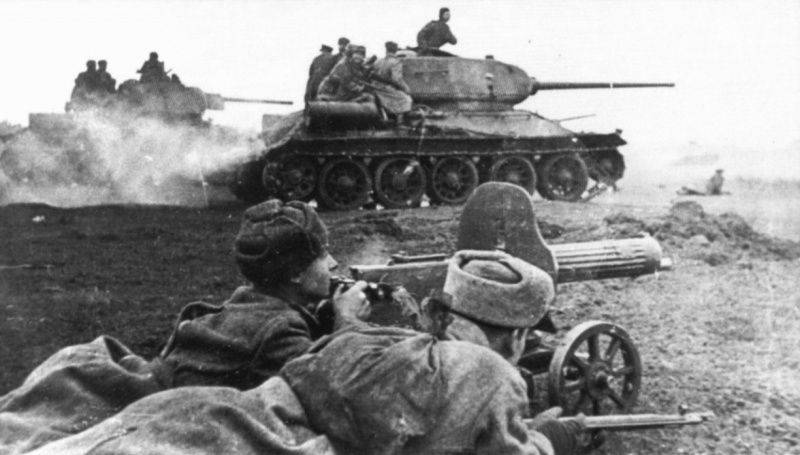
Divisions of tanks and infantry of the 2 of the Ukrainian Front on the approaches to Budapest
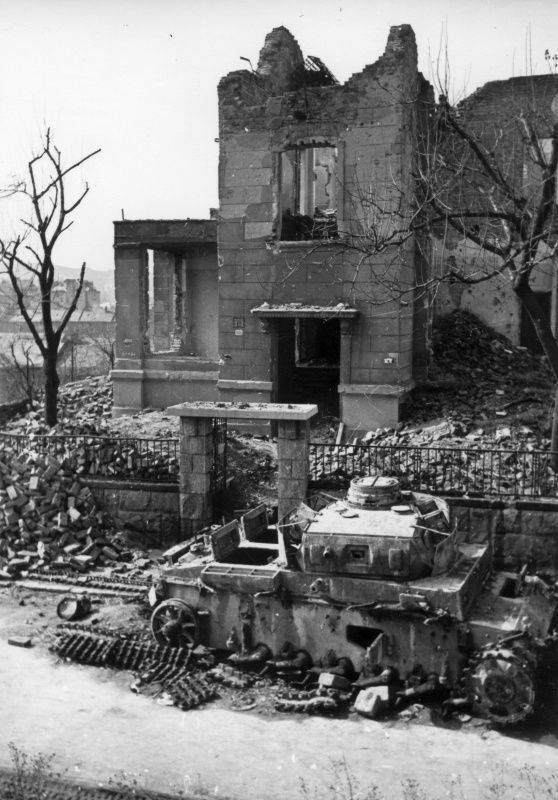
Burnt and dismantled German tank Pz.Kpfw.III on Tigris Street in Budapest
The reasons for the duration of the assault
The duration of the storming of Budapest was associated with several prerequisites. The first and main prerequisites have already been mentioned above - the main and most powerful forces of the two Ukrainian fronts were tied up with heavy fighting, reflecting the strong blows of selected armored formations of the Third Reich. To the west of Budapest and in the area of Lake Balaton, fierce fighting was in full swing. The Germans attacked large armored formations in an attempt to free Budapest and prevent the loss of its last ally, Hungary.
Secondly, the Soviet troops had no significant numerical superiority. In most cases, there was not even a classic triple overweight, which is prescribed when organizing an offensive. In addition, the defending side in a city fighting was in a better position.
Thirdly, the Soviet divisions were exhausted, exsanguinated by previous battles. The corps that were sent for the siege and assault on Budapest, in general, cannot be called “first-class”; most of the “elite” guards, tank, cavalry and rifle formations fought in more dangerous directions. In particular, strong tank corps did not take part in the storming of Budapest. Although during the future assault on Berlin, tanks and self-propelled guns would hardly become the main striking force of the advancing Soviet forces (three tank armies plus armored units of combined-arms armies). In the storming of the Hungarian capital took a small number of tanks and self-propelled guns. This was due to the fact that the Ukrainian fronts had to lead heavy tank battles on the outer ring of the environment. Soviet tanks in Budapest acted alone or in pairs, supporting assault groups. As a result, the remnants of the German-Hungarian armored forces in Budapest were quite comparable with the small tank forces of the advancing Soviet forces.
For the replenishment of the Budapest Group of Forces, older people were sent, soldiers called up from the newly liberated areas, who did not always have high fighting spirit (they were called “Westerners”, “Bandera” and “Moldovans” with irony), former prisoners of war, who, despite the widespread liberal the myth was sent not to the Gulag, but to the active army. The combat readiness of the Romanian troops, which until recently were an enemy of the Red Army and traditionally did not have a high fighting spirit, was also not high.
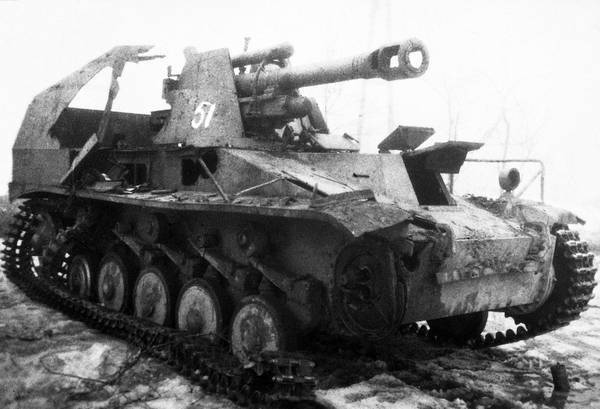
A light 105-mm self-propelled howitzer “Wespe” broken by Soviet artillery fire. Lake Balaton District, February 1945
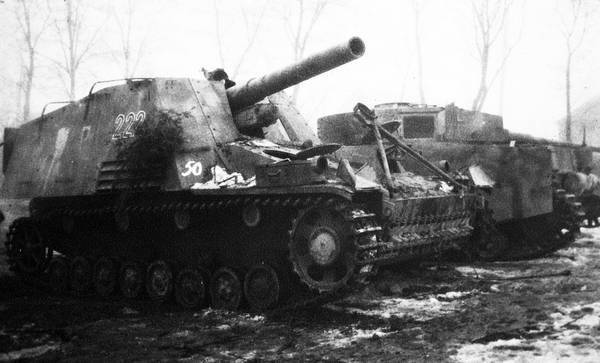
Trophy German armored vehicles: in the foreground 150-mm heavy self-propelled howitzer "Hummel", in the background tank Pz.IV. Lake Balaton District, February 1945
Breakthrough "Attila Line"
A new Soviet offensive on the Pest bridgehead (the previous battles were in November and early December 1944) began on December 20 1944. The forces of three rifle corps were thrown into the offensive. December 25 Soviet-Romanian troops overcame the first and second line of defense so-called. "Attila line", which passed between the suburban villages and urban suburbs. German-Hungarian troops rolled back to a more powerful third line of defense, which passed through the suburbs of the capital.
December 26 Soviet and Romanian troops penetrated the 10 th and 12 th Hungarian divisions. Counterattack battalion "Bath" somewhat improved the position of the defenders. However, December 27 Soviet troops were able to break through the third line of defense of the enemy. The Hungarians retreated.
The command of Army Group "South" and the command of the Budapest garrison believed that Pest must be left, since it was impossible to keep it. The retreat was to stabilize the front, strengthen the Buda garrison, easing its defense or the possibility of a breakthrough from the "boiler". However, Lieutenant-General Grolman, chief of staff of Army Group South, and commander of the 6 Army, General Hermann Balck, argued about when and how to begin the planned retreat. The command of Army Group "South" proposed to withdraw the troops immediately, the commander of the 6 army - gradually. The commander of the garrison Pfeffer-Wildenbruch ordered to prepare for a breakthrough from Budapest. However, the breakthrough did not take place. Hitler ordered not to leave Budapest. The Fuhrer was also against the abandonment of the Peshta bridgehead. The command of the SS 9 Mountain Corps continued to prepare a breakthrough on its own, hoping that Hitler would change his mind. As a result, the hopes of the German generals were not justified. Hitler stood his ground.
The Hungarian command in general did not have the right to vote when making such decisions. The Hungarian General Staff and the commander of the 1 of the Hungarian corps, Ivan Hindi, were planning a breakthrough from the capital from December 26. However, all requests from the Hungarian command Pfeffer-Wildenbruch gave one answer: no retreat!
Fierce battles continued on the Pest bridgehead. The position of the German-Hungarian troops was especially difficult in the northeastern sector of the Peshta bridgehead. Here the Soviet troops reached the city blocks. The German troops counterattacked several times, but all their attacks were choked with blood. In these battles of 28 December 1944, a platoon of Junior Lieutenant Nikolai Ivanovich Khodenko repulsed three counterattacks from superior infantry and enemy tanks, destroying enemy soldiers and officers to 120. Khodenko knocked down three enemy tanks. For this feat, Nikolai Khodenko was presented for the title of Hero of the Soviet Union. In these battles, the Budapest security battalion, which was part of the Hungarian 1 Army Corps, was almost completely destroyed. A part of this battalion went over to the side of the Red Army. In the meantime, Romanian troops captured the Zincote district on the night of 29 on December 30.
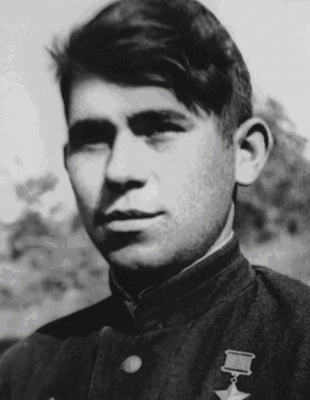
Hero of the Soviet Union Nikolai Khodenko (1926 - 1959)
The shooting of the Soviet parliamentarians
Malinovsky and Tolbukhin understood that the siege of the city and street fighting required a lot of time. At the same time, the Soviet command had already planned an attack on Bratislava and Vienna. A large European city with a population of one million had to be taken as soon as possible. Therefore, on December 29, in agreement with Stalin, the Soviet command offered to capitulate to the German-Hungarian garrison. Numerous indulgence was promised to those who surrendered: after the end of the war, the Germans were promised an immediate return to their homeland, they were offered to keep the awards and uniforms for everyone, the cold officers weapon. Promised a normal diet, the wounded and the sick - medical care. It was an honorable capitulation.
The letter with the ultimatum to Buda was supposed to wait out for Ilya Afanasyevich Ostapenko, and to Pest was a Hungarian by origin, captain Miklos Steinmetz. When a group of Steinmetz with a white flag approached enemy positions, the Germans opened fire with machine guns (according to another version, they fired a cannon at the car). Soviet car was shot. Steinmetz and junior sergeant Filimonenko died on the spot, and the third member of the group, Lieutenant Kuznetsov, was seriously wounded.
The Ostapenko group advanced later and knew about the tragedy of the Steinmetz group, but did not give up its mission. Ostapenko group was also shot at when approaching enemy positions, but no one was hurt. German security escorted the parliamentarians to the headquarters of the SS 8 Cavalry Division. Ostapenko presented an ultimatum to the senior officer, spoke with Pfeffer-Wildenbruch (Ostapenko was fluent in German). The Germans refused to give up. The parliamentarians were blindfolded to the front line and released. On the way back the group came under mortar shelling. Ostapenko died, two other members of the group, Orlov and Gorbatyuk, survived.
There is an opinion that in the conditions of a constant exchange of fire on the front lines, the Steinmetz group was not deliberately destroyed, and the Ostapenko group came under a random shot (perhaps even a “friendly fire” common to all wars). But be that as it may, the Soviet parliamentarians perished, and the Germans rejected the ultimatum.
December 31 about the death of parliamentarians reported by Soviet radio. The Wehrmacht High Command ordered an investigation, since the parliamentarians were officially under the protection of international law. Fragments of shells extracted from Ostapenko’s body by Soviet experts were of Hungarian origin. The commander of the Budapest grouping Pfeffer-Wildenbruch denied his guilt. Moreover, he lurked to such an extent that he even denied the arrival of Soviet officers, reporting on four German servicemen sent as parliamentarians, whom the Soviet soldiers themselves then shot. Despite many witnesses, the SS man misled the higher command. As a result, the German High Command, deceived by Pfeffer-Wildenbruch, stated that the reports of the death of Soviet parliamentarians were "a rude stunt of Soviet propaganda."
Thus, the commandant of Budapest, Pfeffer-Wildenbruch, made it impossible for the Hungarian capital to surrender. And the German high command, using this case for propaganda purposes, the commandants of all the blocked "fortresses" (Budapest, Koenigsberg, Breslau, Poznan, Glogau and Kustrin) and the garrisons, who defended them, categorically forbade entering into negotiations with the Soviet representatives, since they allegedly "Grossly flout" the rules of world law.
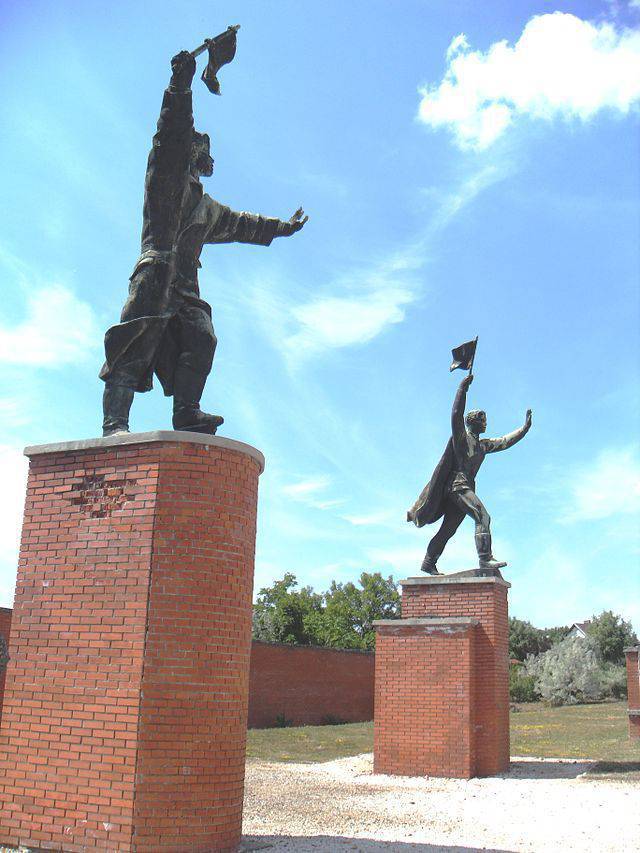
Monuments of Ostapenko and Steinmetz in Memento Park in Budapest
The first stage of the Pest assault (30 December 1944 of the year - 5 January 1945 of the year)
30 December 1944 began a strong artillery and aviation training, it lasted several days. For three days, Soviet artillery and aviation ironed enemy positions. The war turned one of the most beautiful cities in Europe into ruins. For the political mistakes of the Hungarian leadership had to pay the civilian population, which at the end of the battle hid underground.
The German-Hungarian command, which did not plan for a long time to defend the city, which only by the will of Hitler became a “fortress”, did not create significant stocks of ammunition, especially artillery. Therefore, a very numerous German-Hungarian artillery could not fully respond to the Soviet artillery. Ammunition had to be protected. Some heavy shells left without shells were even used to build barricades across Budapest streets. The stock of mines was almost exhausted by the end of December 1944.
Almost simultaneously with artillery and aviation training, taking advantage of the pauses in strikes, the Soviet infantry went on the attack. Formed assault groups. In addition, each infantry regiment had to create a task force, which included a company of machine gunners, a reconnaissance group, as well as a special technical group. In the event of a critical situation, this group had to respond quickly.
Since the beginning of street fighting, artillery was used not to break through the usual defensive line, when most of the guns fired from closed positions, but to fire at direct fire. In order to protect the guns from enemy fire, stone walls, blockages were made in front of them, or, after a shot was fired, the gun was taken out of the walls of buildings. The tanks participating in the assault were divided into groups of 1-2 vehicles, subordinated to the rifle battalions, which formed the assault groups. Tanks now acted as part of the assault groups, shooting enemy firing points.
A large role in the assault played flamethrowers. With a small number of tanks, the troops attacking Budapest had quite a large number of flame throwers. So, by January 6, the 30 th rifle corps was supported by an army battalion of knapsack flame throwers and a 173 of a separate company of roxists (they were armed with ROX knapsack flame throwers), which together counted about one hundred and fifty flame throwers. The 18 th Guards Rifle Corps was reinforced by the 39 th separate Roxist battalion. After the sappers broke through the walls of the buildings that used to be enemy strongholds, the flamethrowers set fire to the building, including the basements, smoking the enemy.
On the very first day, the positions of the enemy's 12 reserve division were broken through. Soviet troops advancing on the southern and eastern outskirts of Pest, captured large areas. By evening, part of the Hungarian troops, retreating to the church in Rakoszentmichai, was completely destroyed. German 13-I tank division tried to counterattack, but suffered heavy losses.
December 31 German-Hungarian troops again counterattacked. In particular, on the southern outskirts of Pest, the 22 th Cavalry SS division launched a counterattack. However, almost all attacks failed. Only in some areas the Germans and Hungarians have slightly advanced. At the same time, the Soviet troops continued the offensive and continued to push the defenders of the Hungarian capital.
1 January 1945. Fighting continued with the same bitterness. Under the threat of encirclement, the troops of the Hungarian 10 th infantry and 12 th reserve divisions were found. Soviet troops in several places broke through the line of defense that ran along the railway embankment. On January 2-3, the Soviet infantry, supported by tanks, continued the offensive. In the first days of the assault, Soviet tanks took the lead, losing contact with the arrows. As a result, these days a small tank group storming (tank battalion of the 3-th tank brigade) lost 7 combat vehicles burned down and 5 downed. Therefore, in the future, tankers organized a more intimate interaction with infantry and artillery, began to fight in the ranks of the assault groups, which led to their greater effectiveness. So January 4 tank battalion lost only one car.
At the same time, the Hungarian troops, despite the fierce resistance, continued to retreat and suffered heavy losses by the dead and prisoners. During the January 3 battle, the number of soldiers in the battalions of the 12-th Reserve Division was reduced to 10-20 people. The weakest in spirit surrendered en masse. After a few more days of combat, the total strength of the 10 th Infantry and 12 th reserve divisions was reduced to 507 people. However, our troops suffered serious losses. So the 2-I Romanian division was exsanguinated, it was taken to the rear. To strengthen the advancing forces in the battle was introduced 36-I Guards Rifle Division.
January 3 The 18 Rifle Corps came close to the Budapest Hippodrome, which the Germans used as an improvised airfield. By the end of January 3, our troops reached the Rakoshsentmihal station. On the night of January 4, with the help of tanks, the echelons stationed at the station were disengaged and pulled apart, freeing up space for infantry attacks.
The German command, trying to strengthen the Hungarian troops and prevent desertion, began to "dilute" the Hungarian soldiers German companies. As a result, almost the entire city came under German command. The defense of Pest was reinforced by German troops. In Pest redeployed part of the 271-th people's grenadier division. The defense of Pest was assigned to the commander of the 13 Panzer Division Gerhard Schmidhuber.
Until January 5, our troops in Pest, gnawing through the fortifications of the enemy, slowly moved forward on the whole front. After this, the front stabilized somewhat, some calm settled. The commander of the 2 Ukrainian Front, Rodion Malinovsky, decided to change the strategy and redistribute efforts around the perimeter of the defense. The enemy put up strong resistance, and it was decided to cease the practice of pressure along the entire front. It was necessary to focus on key areas and crush the defending enemy grouping.
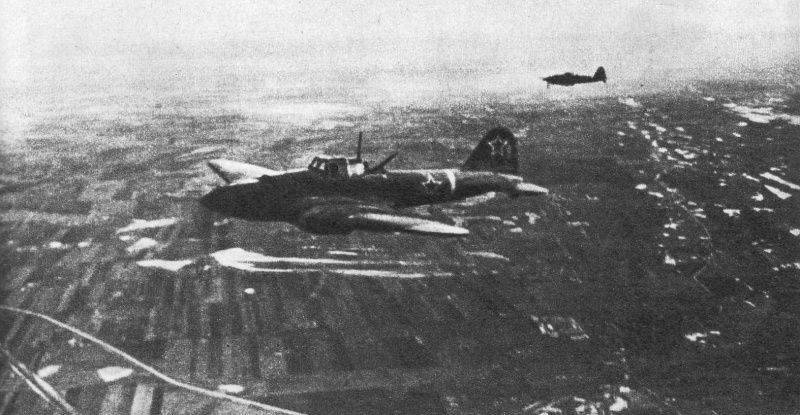
Il-2 17 Air Force ground attack aircraft in flight in the area of Budapest
To be continued ...
Information